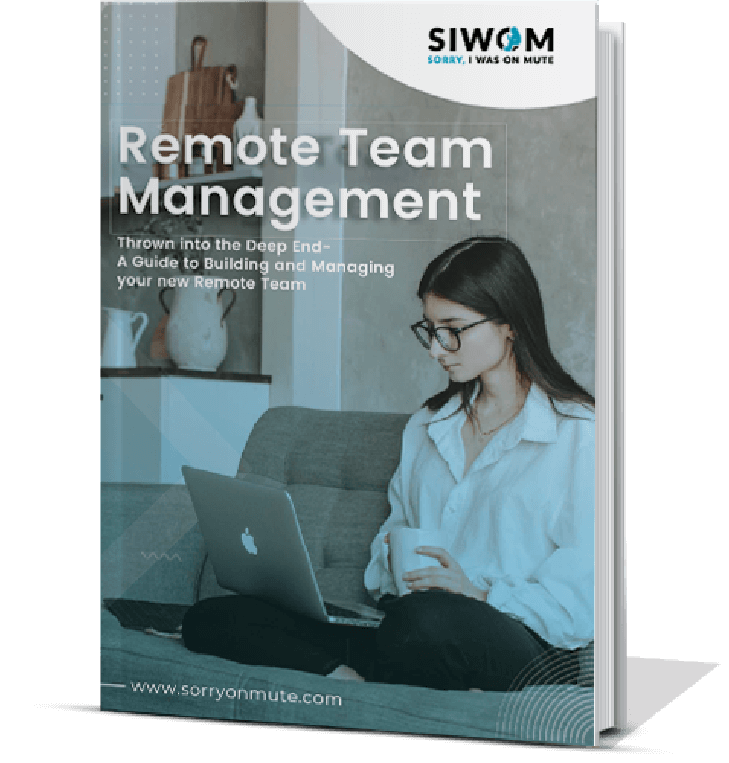1. What is Remote Working Policy?
A remote working policy is a framework of mutually agreed guidelines between the company and employee that govern a work-from-home or remote work setup. This usually comprises all rules and regulations on what a remote worker can and cannot do.
The guidelines also empower the remote employees with all significant information on expected duties, work timings, modes of communications and platforms used for the same, along with benefits and compensation provided. They also explain company policies that cover leave, confidentiality, code of conduct and more to ensure there are no gray areas when it comes to implementing a successful remote or even hybrid work set-up.
2. Why Is It Essential to Implement Remote Workplace Policy?
It’s important to lay down expectations and guidelines in place to protect the interest of both employers and employees by implementing a well-drafted remote work policy. The framework of guidelines can serve as a guiding point for employees on various aspects such as how to work remotely, what hours need to be put in, communication modes, who needs to be contacted for queries, and more. On the other hand, organizations can better manage their remote workforces by updating employees through the remote work policy.
3. What to Include in Remote Workplace Policy?

3.1. Work Expectations
Clearly set expectations will leave no room for confusion or misunderstanding. An effective remote workplace policy should have detailed explanation on work in the specific capacity for each employee entails. This should cover the specific number of hours that need to be clocked in, the number of holidays given, targets that need to be achieved and more. This will help employees take ownership and accountability without the need for follow-ups.
3.2. Communications
Another primary factor that needs to be addressed while formulating a comprehensive remote work policy is communication. Questions on the mode of communication, frequency, response time or frequency of client communication should be clearly answered or elucidated in the remote work policy to ensure everyone is aligned on the same page. Your remote work policy should also explain the kind of communication tools being used to conduct daily meetings, team interactions, emails, conferences and more. This is especially great for employees who are new or being onboarded since they can familiarize themselves with
3.3. Insurance and Liability
Remote workplace policy should update employees on the kind of company benefits such as health insurance and compensation that they will receive. Typically insurance is extended to spouses and parents or children as well. In the event of any mishap that occurs in defined workspace during work hours, an employee can claim insurance through the company as well. Insurance also covers the company equipment and physical assets that have been handed over to the employee for remote work in the set period.
3.4. Security
While remote working has opened a window of opportunities for flexible work from anywhere, it’s made this kind of work more susceptible to the risk of security issues. Data theft, hackware, malware and more can pose a threat for companies. Stipulations on what kind of secure network needs to be used, access to VPN or other software must be specifically listed out in a remote workplace policy. Companies can also ask employees not to access public WiFi when working in a remote setup without prior intimation. This will go a long way in trying to mitigate any potential hazards..
3.5. Compensation
It’s quite natural for remote employees to inquire about the compensation and associated benefits they are entitled to considering the nature of their work model. Explain the compensation package, basic components, variables involved and performance based evaluations for raises that will be considered in the remote workplace policy. It’s also advisable to add in exclusions and exceptions to the same to ensure you've covered all major aspects.
3.6. Other Company Policies
In a remote setup, it’s quite easy to fall into the trap of being too casual or laid back while working from home. Make sure to plug in other company guidelines, generic work regulations on leave or confidentiality, and code of conduct that are applicable in a professional environment. The remote workplace policy needs to ensure that employees are aware of the kind of disciplinary actions that will be taken in case of non-conformity to the rules.
3.7. Eligibility

One common yardstick will not work when it comes to deciding who is eligible for remote work. Unless your organization is a completely remote set-up, you will need to establish some eligibility criteria or parameters that will help in ascertaining who can qualify for remote work. For instance, if the role of an employee requires to have daily client interactions, then it’s unlikely that the employee can avail remote work. Likewise, if there are new employees who need to have constant collaboration in the first few months, remote work is an unlikely prospect. This also applies for employees in the system who may have a history of late attendance or inconsistent work performance. For those who need to take a remote option occasionally, a clause in the policy can be created to accommodate such requests from time-to-time through necessary approvals.
3.8. Internet Security
Consult relevant IT professionals in the organization when it comes to setting up a remote workplace policy that needs to cover internet security. Consider essential components such as the type of internet connection that employees should use, compensation for use of personal internet, internet redundancy and more. The remote workplace policy should cover backup or alternatives in case of slow network speeds.
3.9. Company Equipment
When it comes to remote work, ensure that your remote workplace policy covers all aspects of what kind of company equipment can be handed over to employees as part of their work engagements. Strict clauses should be implemented to ensure that all company related work needs to be completed on only company laptops or desktops and phones. These are not intended for personal use and would be essential so as to not compromise on the security and confidentiality of company data.
3.10. Productivity Metrics
Productivity metrics serve as a scoreboard to help both the company and employees. These are especially useful in remote and hybrid work models so you can measure daily targets, performance on a regular basis and also appraise employees to know how they are faring. The metrics should be a part of a remote workplace policy to inform and educate employees on how their work is being monitored and evaluated.
4. How to Create a Remote Workplace Policy?

4.1. Decide Which Roles Employees can Perform Remotely
The first step is to take stock of various employee profiles in your organization, the nature of work that each profile entails and whether they are remote-friendly or not. Create remote profiles for employees based on these parameters. Jobs that need manual labor, constant front-end communication or those that need to be done in an office space due to the sensitivity of the data being handled need to be considered as exclusions.
4.2. Establish the Rules Very Clearly
While a policy can be very well-drafted, it needs to be implemented as well so employees can take them seriously. Ensure that each policy that concerns a parameter such as leave, code of conduct, attendance etc, has a strict monitoring and follow-up process. Add in details such as email addresses and contact numbers of concerned authorities on these matters so employees can use them in the event of discussions or redressals.
4.3. Develop a Work Plan for Remote Workers
Create SMART goals for every department post discussion with line managers or department heads. These should be measurable in terms of daily, weekly or monthly metrics. Ensure that employees are aware of what is expected from them and give them opportunities to clarify queries if any.
4.4. Ensure that Proper Tools are Given to Employees
Discuss and share the necessary communication and collaboration tools that your remote employees or teams will need to get started. It’s best to ensure you run a trial of the software or processes in advance to avoid last minute glitches that can hamper productivity.
4.5. Determine Communication Practices
Communication is the key to successful remote working. It may not always be possible to take calls or hold meetings, so remote employees need to have the necessary tools that can help them reach out in other ways such as messaging or chat systems in place. Set up consistent practices that employees can inculcate as regular work day habits for effective communication and collaboration such as daily check-ins, weekly updates and more.
5. How To Build A Strong Culture With A Remote Team?

5.1. Hire the Right People
Remote work culture is for, of and by the people. It starts by finding and hiring the right fit. We naturally zoom in on applicants whose skills and areas of expertise fit the job description. And most applicants know they have to impress and will tell you what they think you want to hear.
To give everyone equal footing, a cultural fit assessment should also go into your selection criteria. Presently, this can be a little daunting, what with even hiring processes going virtual. One, you don’t have the advantage of visual and social cues to read potential applicants. And two, you have no sure way of knowing if the person you see online can work well with others.
What you could do is create a mold of desirable traits to compare against incoming profiles. Most situational judgment tests are untimed. However, you have the option to set a time limit if you want to gauge how applicants respond under pressure.
Prospective candidates can get an idea of the type of workplace situations they’re likely to face if you hired them. They can demonstrate their leadership, communication, and critical thinking abilities here. You’ll be able to determine if their soft skills complement or clash with their technical competencies from their responses.
Base your decision to proceed or not after a more thorough understanding of what their strong and weak points are. It only takes the toxicity of one bad hire to go viral and bring everybody else down. To straighten out your hiring processes such that they commit to onboarding members whose professional conduct aligns with the company mission.
5.2. Measure Remote Team Engagement
When different departments coalesce remotely, there will be conflicts and confusion which hide true potential. This is why you should measure the effectiveness of remote work culture. It lets you know what your organization provisions for, and what to improve on to keep talented members. You can use survey sites to create a custom-entry form.
Upload it on a watercooler chat (a joint group that has all your members in it). Have the team fill it out by a specific date. Customize your questions according to the team answering them. The answers you get highlight issues impacting an individual or team performance as a whole.
These surveys give insights into how your teams think and function without being intrusive. It lets you determine the genuineness of problems and helps you address them proactively.
Gathering feedback involves your team in the process of building culture rather than just following it. Besides, they know what keeps them engaged and what won’t. They can come up with suggestions for process improvement, conflict resolution, and behavioral adjustments that you can try out!
5.3. Celebrate Diversity
Sitting behind a screen shouldn’t limit your team members from getting to know one another. The best work culture is one that not only embraces diversity but also celebrates it. Being mindful of your employees’ cultural heritage can help you understand their social norms. You can make moments more memorable with time-honored traditions.
Have your teams fill out an internal survey on their roots. This can be a fun learning exercise, especially with a dispersed remote team!
You then have a lead for organizing cultural activities for remote teams. You can have everyone dress to the colour of a particular country’s flag. Better still, turn your camera on and organize virtual potluck meals for your teams!
Such remote team rituals reinforce the type of remote team communication etiquette you expect your members to follow. However, if it gets a lukewarm reception, you should also be prepared to let these initiatives go. The point is to show that you care about your staff.
5.4 Make Accountability Clear
Accountability goes both ways. Team culture thrives only when members feel that they truly belong to the organization.
The first step towards achieving this is to make them accountable for the work they are assigned. Only then can they add the most value in context to the business strategy. Set clear expectations for all your remote workers and use messaging and collaborative platforms to hear from them as well.
Your team shouldn’t turn on each other and resort to bullying and transferring blame when the going gets tough. It stands in the way of improving team morale.
Instead, keep everyone accountable for their work, not in-seat hours. Creating this accountability not only keeps your teams grounded but also makes dealings transparent.
In other words, everyone is clear of the dependencies within their work. Team members know who to connect with when the need arises. Management should make their workforce aware of the changes in governance and leadership as and when it’s decided. Only then can they know who to report to.
5.5. Recognize the Stalwarts
A remote work culture recognizes exceptional workers, no matter how long they’ve been working remotely. Here are a few tips to take employee recognition forward:
1. Run performance numbers by individual contributions to identify who made them. You can then create a list of people to thank for the next weekly call.
2. Initiate virtual appreciation days on group chats. Highlight who is behind the success on that particular day, or week.
3. Incentivize unplugging with e-commerce vouchers or a complimentary off to workers who’ve been putting in overtime while working remotely.
4. Assign e-mentors to junior or new hires to help get them through onboarding, probation, and subsequent assignments. An e-buddy eases workers into the routine and is a central point of contact for any issues faced.
5. Video in with zoom and use breakout rooms to split up virtual teams into smaller sizes. This feature comes in handy when organizing team bonding exercises.
Failing to appreciate the high-performers is fatal for employee morale. They gradually lose interest in what they do and cause others to follow suit. Pretty soon, your top talent turns out to be mediocre. Make it clear where you stand on performance and rewards for quality of work.
Organize one on ones on a quarterly basis to check in with your employees. Assess if there was any improvement between the last conversation and the present outcome. Remember, your staff is observing your actions just as you’re observing them.
When they see stalwarts being appreciated and rewarded, they too are encouraged to aim higher. Besides, appraisals are an opportune moment for them to know what they’re getting right and what they could improve further on.
5.6. Emphasize on Continuous Improvement
Don’t make building up remote work culture a one-time exercise. The mark of strong and positive work culture is one that lets employees adapt to dynamic business shifts. The steps to working on cultural improvements are to-
1. Keep your teams involved and informed at all times, no matter where their location. In doing so, change measures face less resistance. For example, reskilling and upskilling measures. Make them aware of the external market conditions. They can then use their newly upgraded skills to a) remain employable and b)steady the business against any fluctuations.
2. Appoint a trustworthy (and preferably, senior) point of contact, to convey news and business updates to physical, distributed, and remote teams.
3. Recenter virtual meetings around relevance and moderate announcements. Everyone present can raise questions, which include how these updates impact individual departments, roles, competencies, and knowledge areas.
By focusing on continuous improvement, your priority remains to be more intentional about fostering transparency within the organization, thus preventing stagnation.
6. Hybrid - Remote Work Policy Sample
- Introduce the Company with relevance to hybrid and remote work and how it has been successfully transitioned in the wake of the pandemic so the context is more remote work policy Covid-centric.
We began hybrid and remote work in 2010 and believe that placing the needs of our employees at the forefront is a catalyst for success. Our remote workplace policy is a comprehensive guide that will help remote employees understand all governing rules and regulations along with expectations of a remote set at the company. Please peruse the information to have a thorough understanding of how your work journey will commence at the company. In case of any queries, you may reach out to the HR department at XXX@company.com.
- State the eligibility criteria and remote work pattern for employees to understand if they qualify for remote work and if yes, what specifics it stipulates.
Employees at our company have the option to work from the office, work from home on a permanent basis or on a periodic basis as needed. As the case may be, you are requested to have a discussion with your immediate reporting manager to arrive at a mutually agreed work pattern that covers a total of 40 hours on weekly basis
- Explain the steps or details on how to go about with a request to work from home
If you have worked for a period of 120 days and above, then you are eligible for a discussion on remote work options. This will be subject to the nature of work and your reporting manager considering the interests of the team and project at large. Once a decision has been made, you are requested to email the concerned departments and obtain necessary approvals to initiate a transition to remote work or work-from-home.
- Stipulate the necessary standards of conduct and communication that need to be followed for remote work.
We work as a cohesive unit and are committed to maintaining the highest standards of conduct and commitment towards the achievement of our business goals. Kindly refer to the code of conduct handbook and communications standards manual to familiarize yourself with the expectations of remote work facility
In case of any requests pertaining to a personal issue that may interfere with the day’s operations, you are requested to bring it to the notice of your reporting manager using official channels of communications.
Employees are expected to remain available at all times during the set working hours and to use the company’s communications and collaboration tools to ensure work goals are met on a daily basis.
- List out the tools and other assets that the company has provided to facilitate remote work for the employee.
In the interest of protecting the confidentiality of all the work at the company, employees who are opting for remote work must use company provided laptops and phones for all kinds of communications. All essential software and a secure VPN connection will be provided to enable smooth transitions. The company will reimburse a standard monthly cost for use of the internet while at home for which you may fill out a form at the end of every month with necessary proofs.
7. FAQs
7.1 How do you implement a remote working policy?
You can implement a remote working policy by empowering your employees with necessary communication and collaboration tools along with the vital information they need to effectively put the policies in practice. Some of the parameters above are a great start point when it comes to drafting and implementing one.
7.2 How can I monitor work from home employees?
You can leverage the efficacy of online tools such as time tracking software, email activity monitoring software, project management software and schedulers to ensure remote teams are managed well. This could be in addition to daily standups, weekly meetings and conferences using a range of communication tools.
 Interested in Virtual Team Building Events?
Interested in Virtual Team Building Events?





















